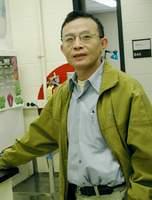個人簡介
倪敏教授1982畢業於山東農業大學,先後獲美國肯塔基大學作物學碩士及美國奧克拉荷馬大學植物學博士。然後在美國普渡大學及加州大學伯克利分校從事博士後研究。美國明尼蘇達大學雙城校區植物生物學系教授。山東農業大學生科院植物發育分子生物學教授。
教學工作
研究生《植物發育分子生物學》
研究方向
棉實驗室早年主要研究光形態建成和幼苗去黃化。發現了一個光信號途徑中非常重要的組成成分PIF3,並分別在Cell(1998)和Nature(1999)上發表了論文研究其主要功能,兩篇論文均為第一作者,已被引用500次以上。最近幾年,我們利用遺傳、分子生物學、細胞生物學和生物化學等手段將研究擴展到擬南芥和油菜的光調控氣孔和種子發育方向。獲多項美國國家科學基金及美國農業部資助。我們繼續開展光形態建成方面的研究並且鑑定了一組對紅藍光敏感的突變體。這些突變體同樣破壞藍光誘導的氣孔開放反應。突變體植株通過減少氣孔活動來減少水分流失使得植株更耐乾旱。氣孔受自然環境中的藍光調節,被認為由藍光/紫外A光吸收的向光蛋白和藍光受體介導。連線藍光感應氣孔開放的相應信號組件在很大程度上是未知的。我們現在正在研究這些組件在光導氣孔運動的信號轉導通路中的相互作用,已經在Plant Cell and PLoS Genetics發表了一系列的研究論文。我們的很多突變體也顯示種子擴大或縮小的表型。擬南芥種子的發育首先經歷了一個胚乳迅速增多的過程,而隨後一個時期里胚乳又被迅速的消耗掉。種子大小由母本胚珠、胚乳和胚胎的生長相互協調決定。這種調控機制仍然沒有得到很好的解釋。但是種子構成了食物的主要來源。我們已經確定SHB1和其他的一些基因控制擬南芥和油菜的種子發育。目前,我們正在研究4個基因調節種子發育的分子機制。在這個領域,我們已經在Plant Cell 、PLoS Genetics 和Current Opinion in Plant Biology 發表了多篇論文。
光信號轉導及光形態建成方向:1. 我們主要集中研究表觀遺傳修飾調控因子CLF與轉錄調控因子SHB1如何相互作用,以及這種相互作用的生物學意義是什麼。同時研究SHB1是如何被招募到光信號調控因子PIF3和PIF4的啟動子上,並調控其表達。2. 我們篩選到一個參與紅光信號傳導途徑半顯性突變體62和一個參與紅光和遠紅光信號傳導途徑的隱性突變體113。通過本實驗室已建立的高通量測序與圖位克隆相結合的方法,可在短時間內鑑定出其突變位點,並進一步研究其生理生化功能。
胚乳發育及種子發育方向:1. 通過對shb1-D進行EMS誘變篩選到2個抑制shb1-D表型的突變體,粗定位和高通量測序確定突變的SNP位點,進而研究其生理生化功能。2. 本實驗室研究一個在胚乳與種子發育過程中起重要作用的富含亮氨酸的跨膜受體激酶,我們計畫進一步研究其表達的位置,以及它的結合的配體和調控的底物,以進一步揭示種子發育的分子調控機理。華蜜蜂抗病抗逆分子生物學
科研項目
1. 國家自然科學基金面上項目,CLF抑制及SHB1激活PIF3和PIF4 表達的研究,2015-2018,主持
2. 光信號傳導及種子發育,山東農業大學, 2013-2018,主持
發表論文
1. Xiao, Y., Kang, X., and Ni, M. (2014). SHB1 or HAIKU2 mixexpression alters canola and Arabidopsis seed development.
2. Kang, X., Li, W., Zhou, Y., and Ni, M. (2013). A WRKY transcription factor recruits SYG1-like protein SHB1 to activate gene expression and seed cavity enlargement. PLoS Genetics. 9(3): e1003347.
3. Chen, C., Xiao, Y., Li, X., and Ni, M. (2012). Light-regulated stomatal aperture in Arabidopsis. Molecular Plant 5, 566-572.
4. Sun, X., Kang, X., and Ni, M. (2012). Hypersensitive to Red and Blue 1 and its modification by Protein Phosphatase 7 are implicated in the control of Arabidopsis stomatal aperture. PLoS Genetics 8(5): e1002674.
5. Sun X., and Ni M. (2011). HYPOSENSITIVE TO LIGHT, an alpha/beta fold protein, acts downstream of HY5 to regulate Arabidopsis seedling de-etiolation. Molecular Plant 4, 116-126.
6. Sun X., Shantharaj D., Kang X., and Ni M. (2010). Transcriptional and hormonal signaling control of Arabidopsis seed development. Current Opinion in Plant Biology 13, 611-620.
7. Zhou Y., and Ni, M. (2010). SHB1 truncations and mutations alter its association with a signaling protein complex. Plant Cell 22, 703-715.
8. Zhou Y., and Ni, M. (2009). SHB1 plays dual roles in photoperiodic and autonomous flowering. Developmental Biology 331, 50-57.
9. Zhou Y., Zhang, X., Kang, X., Zhao, X., Zhang, X., and Ni, M. (2009). SHORT HYPOCOTYL UNDER BLUE1 associates with MINISEED3 and HAIKU2 promoters in vivo to control Arabidopsis seed development. Plant Cell 21, 106-117.
10. Kang, X., Zhou, Y., Sun, X., and Ni, M. (2007). HYPERSENSITIVE TO RED AND BLUE 1 and its C-terminal regulatory function control FLOWERING LOCUS T expression. Plant Journal 52, 937-948.
11. Chen, M., and Ni, M. (2006). RED AND FAR-RED INSENSITIVE 2, a RING-domain zinc-finger protein, negatively regulates CONSTANS expression and photoperiodic flowering. Plant Journal 46, 823-833.
12. Kang, X., and Ni, M. (2006). Arabidopsis SHORT HYPOCOTYL UNDER BLUE 1 contains SPX and EXS domains and acts in cryptochrome signaling. Plant Cell 18, 921-934.
13. Chen, M., and Ni, M. (2006). RED AND FAR-RED INSENSITIVE 2, a RING-domain zinc-finger protein, mediates phytochrome-controlled seedling de-etiolation responses. Plant Physiology 140, 457-465.
14. Ni, M. (2005). Integration of light signaling with photoperiodic flowering and circadian regulation. Cell Research 15, 559-566.
15. Kang, X., Chong, J., and Ni, M. (2005). HYPERSENSITIVE TO RED AND BLUE 1, a ZZ-type zinc finger protein, regulates phytochrome B-mediated red and cryptochrome-mediated blue light responses. Plant Cell 17, 822-835.
16. Ni, M., Tepperman, J., and Quail, P.H. (1999). Binding of phytochrome B to its nuclear signaling partner PIF3 is reversibly induced by light. Nature 400, 781-784.
17. Ni, M., Tepperman, J., and Quail, P.H. (1998). PIF3, a phytochrome interacting factor necessary for photoinduced signal transduction, is a basic helix-loop-helix protein. Cell 95, 657-667.
18. Ni, M., Dehesh, K., Tepperman, J., and Quail, P.H. (1996). GT-2: In vivo transcriptional activation activity and definition of twin novel DNA-binding domains with reciprocal target-site selectivity. Plant Cell 8, 1041-1059
 倪敏
倪敏![倪敏[山東農業大學教授] 倪敏[山東農業大學教授]](/img/5/63d/nBnauM3X0QjN2ATOwcDM3kTO0UTMyITNykTO0EDMwAjMwUzL3AzLwQzLt92YucmbvRWdo5Cd0FmLxE2LvoDc0RHa.jpg)
